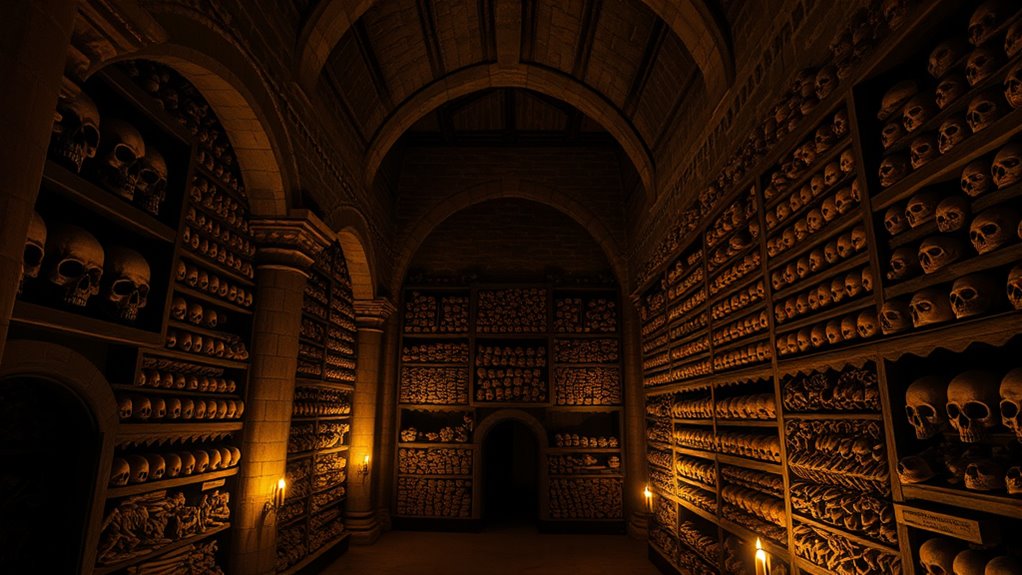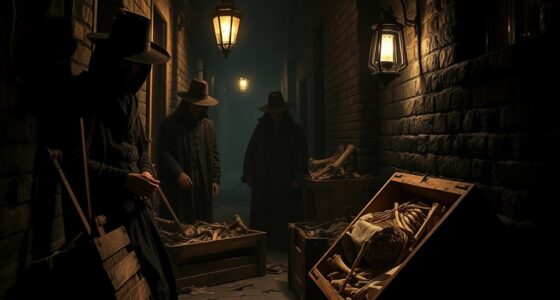Charnel houses and ossuaries originated as practical solutions to overcrowded cemeteries, allowing societies to store bones after burial space was exhausted. They serve both as respectful resting places and symbolic displays of remembrance, often reflecting spiritual beliefs and cultural values through intricate designs and arrangements. These structures transform death into a form of art and memory, fostering connections between the living and the departed. Exploring further reveals how their history reveals much about cultural attitudes toward death and remembrance.
Key Takeaways
- Charnel houses and ossuaries originated as practical solutions to overcrowded cemeteries, storing bones after decomposition.
- They serve as memorial spaces, transforming human remains into sacred, artistic displays reflecting cultural beliefs.
- Their design often incorporates symbolic arrangements and religious iconography to honor the deceased.
- These structures embody societal values, emphasizing reverence, remembrance, and spiritual connection with the dead.
- Historically, they illustrate humanity’s response to space limitations while fostering cultural identity and continuity.

Charnel houses and ossuaries serve as practical solutions for storing and honoring human remains when burial space runs out. These structures are more than just storage units; they embody a rich history of funerary architecture and cultural symbolism. As you explore their origins, you’ll discover that their designs and uses reflect deep-seated beliefs about death, memory, and respect for the deceased. Throughout history, societies have faced the challenge of managing limited burial space, and ossuaries emerged as a creative response. They often feature intricate architectural details, emphasizing their role in religious and cultural practices. The design choices—such as stacked bones or decorative niches—are deliberate, serving both practical and symbolic purposes. Funerary architecture in these structures often aims to create a sacred space that honors the dead while accommodating the growing number of burials in crowded cemeteries.
The cultural symbolism embedded in charnel houses and ossuaries reveals much about societal values and spiritual beliefs. In many cultures, bones are seen as the core of a person’s identity, and their display signifies reverence and remembrance. For instance, some European ossuaries feature elaborate carvings or religious iconography, emphasizing the connection between life, death, and the divine. These symbols serve to remind the living of mortality and the hope of resurrection or eternal life. The arrangement of bones in these structures can also convey social status or familial ties, transforming mere leftovers into meaningful memorials. You might notice that in some traditions, bones are arranged in specific patterns or shapes, reinforcing cultural narratives about life and death.
Furthermore, the use of space within these structures often reflects community values. In places like the Sedlec Ossuary in the Czech Republic, the bones are arranged artistically, turning death into a form of art that invites reflection. Such funerary architecture elevates the concept of remembrance beyond mere storage, transforming it into a cultural statement. Additionally, the emphasis on symbolism in their design highlights how societies interpret death and the afterlife, influencing their funerary customs. As you study these structures, you’ll see that they serve as tangible links between the living and the dead, fostering a sense of continuity and respect. They also challenge us to consider how societies deal with mortality and how cultural symbolism shapes our understanding of death. Ultimately, charnel houses and ossuaries stand as enduring testaments to human creativity, spirituality, and the universal desire to honor those who have passed on.
Frequently Asked Questions
How Are Ossuaries Constructed to Preserve Remains?
Ossuaries are constructed using specific techniques to enhance bone preservation. You’ll find that they often have thick, airtight walls or sealed compartments to protect remains from moisture and pests. Construction techniques include lining with mortar or plaster, which help stabilize the bones and prevent deterioration. Proper ventilation also plays a key role in maintaining dry conditions, ensuring bones stay intact and well-preserved over time.
What Cultural Taboos Influenced Ossuary Designs?
You should know that cultural taboos around funeral customs and ancestor veneration heavily influence ossuary designs. Many cultures avoid exposing remains or direct contact with the dead, so ossuaries are created to respect these beliefs, often incorporating symbols or arrangements that honor ancestors while maintaining modesty. These taboos shape how ossuaries are constructed, emphasizing reverence and ensuring that the resting places align with cultural values.
Are There Modern Practices Similar to Traditional Ossuaries?
Ever wonder if modern burial trends echo ancient practices? Today, you see contemporary memorials like columbariums and eco-friendly urns that resemble traditional ossuaries. These practices emphasize space efficiency, environmental concerns, and personalized remembrance, much like old ossuaries stored bones in sacred spaces. Do these modern methods honor the same cultural reverence for the dead? They certainly reflect a continued fascination with preserving memory in innovative ways.
How Do Different Religions View Ossuaries Today?
You’ll find that different religions have diverse views on ossuaries today. In Catholicism, they symbolize religious devotion and respect for the dead, often used in modern adaptations of traditional practices. Hinduism and Buddhism see them as part of spiritual symbolism, emphasizing the cycle of life and death. Some groups may avoid ossuaries altogether, while others preserve their cultural heritage through these practices, blending tradition with contemporary religious symbolism.
What Are the Archaeological Challenges in Studying Ossuaries?
Like steering through a labyrinth, studying ossuaries presents archaeological challenges. Preservation techniques are vital, yet delicate, as they can be easily compromised during excavation. You face difficulties in carefully unearthing remains without damage, and deciphering their historical significance can be like piecing together a fragmented mosaic. These hurdles demand meticulous methods and patience, ensuring that each discovery preserves the stories etched within these ancient containers for future understanding.
Conclusion
As you stand before these sacred vaults, imagine them as silent gardens of memory, where bones bloom like delicate flowers in a structured meadow. Charnel houses and ossuaries cradle history’s whispers, turning decay into reverence. They remind you that beyond the bones lies a tapestry of stories, woven into the very stones. In these hallowed spaces, life’s fleeting nature is etched in stone, urging you to cherish each moment before it too becomes part of the eternal cycle.









